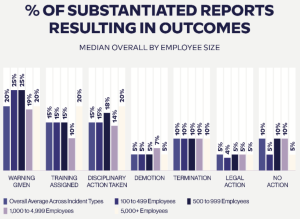When it comes to the important topic of employee whistleblowing, a number of issues always crop up.
Typically these fall into three areas: how staff can be encouraged to report serious workplaces incidents in the first place; whether their claims will be taken seriously, and whether anything will actually happen to once a claim is made and an investigation is concluded.
The good news – as data from Case IQ’s ’2024 Investigative Case Management Benchmark Report’ reveals – is that when incidents are actually substantiated (the average is that around 40% are), then in the vast majority of cases (90%) definitive action is taken.

However, the significant finding from this year’s report is that if HR departments want to encourage more incidents in the first place (anonymously typically), then there is data to show that more reporting is directly proportional to the number of channels HR offers to allow incidents to be reported.
In other words, the more ways HR can offer staff to report, the more likely it is that employees will engage and actually report things they see that don’t seem right.
Reporting facts
Starting from the beginning – the actual reporting part – it is estimated that approximately 30% of workplace incidents are reported anonymously (see below)

But, there is clear evidence how, that shows this figure can be higher or lower specifically due to the number of different reporting channels you have in place. [By different channels, we mean everything from email, to web portals, to direct contact, chatbots, live hotlines, text, SMS chat, mobile apps etc).
So, if you are looking to foster a positive environment for employees, HR professionals need to know that it starts with diverse reporting options.
Offering multiple channels for employees to report concerns will increase reporting rates, improve investigation outcomes, and ultimately create a safer and more inclusive work environment.
Let’s look at these impacts a little more closely:
The importance of anonymous reporting
Anonymous reporting is the first critical component of any successful whistleblower program.
It allows employees to report misconduct without fear of retaliation, which is particularly important in environments where fear of retribution may discourage reporting.
Further, anonymity encourages more employees to come forward, uncovering issues that might otherwise remain hidden.
As such, organizations must develop protocols that protect the reporter’s identity while still allowing for a comprehensive investigation.
By doing so, they can maintain a high level of trust among employees, which is essential for the long-term success of the whistleblowing program and the organization as a whole.
The benefit expanding reporting systems brings
Reporting systems are a cornerstone of any comprehensive workplace safety program.
Taking an omni-channel approach not only leads to more comprehensive data collection, allowing organizations to identify and address issues more effectively, but it is those organizations who offer multiple intake methods that see higher rates of both anonymous and non-anonymous reporting.
Our data shows that organizations that offer four or five intake channels receive 52% more reports than those with only two or three channels.

This significant increase in reporting is also directly linked to improved transparency and higher investigation and substantiation rates.
Diversified intake methods can include traditional channels like hotlines and email, as well as more modern options like web portals, mobile apps, and even in-person reporting.
By catering to different communication preferences, organizations can ensure that all employees feel comfortable and supported in reporting their concerns.
This inclusivity not only improves reporting rates but also enhances the overall safety and well-being of the workplace.
Ensuring the effectiveness of intake methods
But while expanding the number of channels will boost reporting, this expansion must come with an organization-wide commitment to regular reviews and updates.
This will allow them to maintain high substantiation rates and ensure that their reporting systems remain effective over time.
To measure channel effectiveness, HR professionals should:
- Gather feedback from employees about the usability and accessibility of reporting channels. This is essential for identifying areas of improvement.
- Train employees on how to use these channels effectively to ensure that they are aware of their rights and the protections in place.
- Standardize investigation processes and properly allocate resources to ensure that all cases are handled efficiently, consistently, and fairly.
Final thoughts: Fostering a safer workplace environment
Diversifying intake methods is a powerful strategy for creating a positive and safe workplace.
By offering multiple reporting channels, supporting anonymous reporting, and regularly reviewing the effectiveness of intake methods, organizations can foster a culture of transparency and accountability.
This approach not only improves reporting rates but also enhances the overall safety and well-being of the workplace, ensuring that all employees feel heard and valued.
Organizations committed to creating a safe and positive workplace should evaluate their current intake methods and consider implementing diversified channels to better support their workforce.
